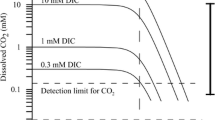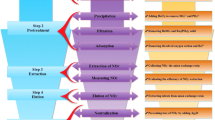Abstract
This article reports the first application of coupled total organic carbon cavity ring-down spectroscopy (TOC-CRDS) for the analysis of the δ13C signature of dissolved organic carbon (DOC) in freshwater samples. DOC represents a major, dynamic component of the global carbon cycle. The export of DOC from soils into rivers and groundwaters may be highly climate sensitive, and much of this export may occur in ephemeral fluxes. Thus, a robust, simple and inexpensive method for the continuous determination of DOC concentration and quality is urgently needed. We detail recent advances made in the analysis of the δ13C signature of DOC using a TOC-CRDS system optimised for the analysis of DOC with natural abundances greater than 2.5 mg L−1 with no sample pre-concentration required and sample volumes of 40 mL. Precision between replicated samples was comparable to conventional analysis by gas-source isotope ratio mass spectrometry, yielding δ13C values with standard deviations of ± 0.5 ‰ for DOC concentrations higher than 1.5 mg L−1. The utility of this technique for the analysis of DOC in samples with a broad range of compositions and concentrations (2.5–25 mg L−1 DOC) is demonstrated. Since DOC δ13C can be measured continuously, ca. 45 min per measurement, this method enables the online monitoring of DOC in river water, water intakes and treated waters, allowing changes in DOC fluxes to be monitored in real time.



Similar content being viewed by others
References
AMCTB (2006) Uncertainties in concentrations estimated from calibration experiments. In: Thompson M (ed) Analytical Methods Committee Technical Brief, vol 22, pp 1–2. Available: http://www.rsc.org/images/concentrations-calibration-experiments-technical-brief-22_tcm18-214840.pdf. Accessed 18 June 2012
Amiotte-suchet P, Linglois N, Leveque J, Andreux F (2007) 13C composition of dissolved organic carbon in upland forested catchments of the Morvan Mountains (France): influence of coniferous and deciduous vegetation. J Hydrol 335:354–363
Andrews DM, Lin H, Zhu Q (2011) Hot spots and hot moments of dissolved organic carbon export and soil organic carbon storage in the shale hills catchment. Vadose Zone J 10:943–954
Arneth A, Harrison SP, Zaehle S, Tsigaridis K, Menon S, Bartlein PJ, Feichter J, Korhola A, Kulmala M, O’Donnell D, Schurgers G, Sorvari S, Vesala T (2010) Terrestrial biogeochemical feedbacks in the climate system. Nat Geosci 3:525–532
Baker MA, Valett MH, Dahm CN (2000) Organic carbon supply and metabolism in a shallow groundwater ecosystem. Ecology 81:3133–3148
Baker A, Cumberland S, Hudson N (2008) Dissolved and total organic and inorganic carbon in some British rivers. Area 40:117–127
Bass AM, Bird MI, Munksgaard NC, Wurster CM (2012) ISO-CADICA: isotopic—continuous, automated dissolved inorganic carbon analyser. Rapid Commun Mass Spectrom 26:639–644
Berryman EM, Marshall JD, Rahn T, Cook SP, Litvak M (2011) Adaptation of continuous-flow cavity ring-down spectroscopy for batch analysis of δ13C of CO2 and comparison with isotope ratio mass spectrometry. Rapid Commun Mass Spectrom 25:2355–2360
Craft JA, Stanford JA, Pusch M (2002) Microbial respiration within a floodplain aquifer of a large gravel-bed river. Freshw Biol 47:251–261
Dalzell BJ, Filley TR, Harbor JM (2007) The role of hydrology in annual organic carbon loads and terrestrial organic matter export from a midwestern agricultural watershed. Geochim et Cosmochim Acta 71:1448–1462
El-Farhan YH, Denovio NM, Herman JS, Hornberger GM (2000) Mobilization and transport of soil particles during infiltration experiments in an agricultural field, Shenandoah Valley, Virginia. Environ Sci Technol 34(17):3555–3559
Findlay SEG, Sinsabaugh RL, Sobczak WV, Hoostal M (2003) Metabolic and structural response of hyporheic microbial communities to variations in supply of dissolved organic matter. Limnol Oceanogr 48:1608–1617
Foreman CM, Covert JS (2003) Linkages between dissolved organic matter composition and bacterial community structure. In: Findlay SEG, Sinsabaugh RL (eds) Aquatic ecosystems: interactivity of dissolved organic matter, 1st edn. Academic Press, California, pp 343–359
Gandhi H, Wiegner TN, Ostrom PH, Kaplan LA, Ostrom NE (2004) Isotopic (13C) analysis of dissolved organic carbon in stream water using an elemental analyzer coupled to a stable isotope ratio mass spectrometer. Rapid Commun Mass Spectrom 18:903–906
Hartland A, Fenwick GD, Bury SJ (2011) Tracing sewage-derived organic matter into a shallow groundwater food web using stable isotope and fluorescence signatures. Mar Freshw Res 62:119–129
Munksgaard NC, Wurster CM, Bird MI (2011) Continuous analysis of δ18O and δD values of water by diffusion sampling cavity ring-down spectrometry: a novel sampling device for unattended field monitoring of precipitation, ground and surface waters. Rapid Commun Mass Spectrom 25:3706–3712
O’Leary MH (1988) Carbon isotopes in photosynthesis. Bioscience 38(5):328–336
Orphan VJ, House CH, Hinrichs KU, McKeegan KD, DeLong EF (2001) Methane-consuming archaea revealed by directly coupled isotopic and phylogenetic analysis. Science 293:484–487
Pabich WJ, Valiela I, Hemond HF (2001) Relationship between DOC concentration and vadose zone thickness and depth below water table in groundwater of Cape Cod, USA. Biogeochemistry 55:247–268
Picarro (2010) Picarro iTOC-CRDS isotopic carbon analyzer datasheet. Available: http://www.picarro.com/isotope_analyzers/carbon_isotopes_itoc_crds. Accessed 4 Apr 2012
Rasmussen C, Southhard RJ, Horwath WR (2006) Mineral control of organic carbon mineralization in a range of temperate conifer forest soils. Glob Change Biol 12:834–847
Roulet N, Moore TR (2006) Environmental chemistry: browning the waters. Nature 444:283–284
Rousseau M, Di Pietro L, Angulo-Jaramillo R, Tessier D, Cabibel B (2004) Preferential transport of soil colloidal particles: physicochemical effects on particle mobilization. Vadose Zone J 3(1):247–261
Schelde K, Moldrup P, Jacobsen OH, de Jonge H, de Jonge LW, Komatsu T (2002) Diffusion-limited mobilization and transport of natural colloids in macroporous soil. Vadose Zone J 1(1):125–136
Sen TK, Khilar KC (2006) Review on subsurface colloids and colloid-associated contaminant transport in saturated porous media. Adv Colloid Interface Sci 119(2–3):71–96
Acknowledgments
This work was funded by the National Centre for Groundwater Research and Training, an Australian Government initiative supported by the Australian Research Council and the National Water Commission. The analytical equipment used in this study was funded through the Australian Government Groundwater Education Investment Fund. We also acknowledge funding to YS through ARC grant LP1002000259 and a scholarship from Water Quality Research Australia.
Author information
Authors and Affiliations
Corresponding author
Rights and permissions
About this article
Cite this article
Hartland, A., Baker, A., Timms, W. et al. Measuring dissolved organic carbon δ13C in freshwaters using total organic carbon cavity ring-down spectroscopy (TOC-CRDS). Environ Chem Lett 10, 309–315 (2012). https://doi.org/10.1007/s10311-012-0377-z
Received:
Accepted:
Published:
Issue Date:
DOI: https://doi.org/10.1007/s10311-012-0377-z




